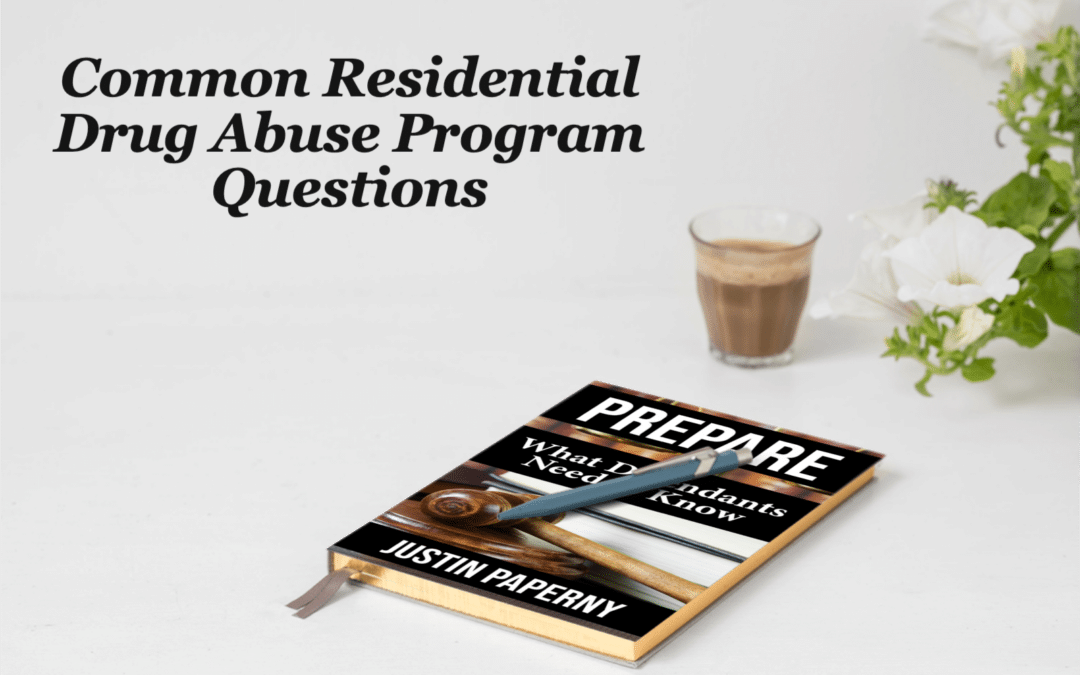Recently, I posted a video that addressed how and why some people in federal prison get thrown out of the Residential Drug Abuse Program (RDAP). That video lead to a number of questions about the program, how to qualify and more. For that reason, I figured I would post this blog I call: Common Residential Drug Abuse Program Questions. So here we go!
What is the Residential Drug Abuse Program?
RDAP is a voluntary, nine-month, 500-hundred hour program. RDAP embraces a comprehensive and intensive therapeutic community model focused on substance abuse, addiction, criminal thinking patterns, coping skills and more. Further, besides the therapeutic model, three groups of treatment are covered: small, module and self help groups. To learn more about each model and group, schedule a call now
Does RDAP only benefit federal prisoners? Who is ineligible for RDAP?
Prisoners convicted of violent crimes are ineligible. Additionally, felony convictions of rape, assault, robbery or child sexual-abuse will disqualify you. Moreover, violence and use of a weapon or firearm will disqualify you.
How much time will I receive off my federal prison sentence if I get admitted into RDAP?
If your sentence is 24-30 months, you’ll earn a 6-month sentence reduction. If your sentence is 31–36 months, you’ll earn a 9-month sentence reduction. If your sentence is 37 or more months, you’ll earn a 12-month sentence reduction
Are there any cons to participating in RDAP?
Yes. Due diligence is advised before enrolling in any prison program, including RDAP. Schedule a call to learn more.
What if I get sentenced to a federal prison that does not have RDAP?
Not all federal prisons have RDAP. To view the RDAP facility list click here. Once you are accepted into RDAP you will be transferred to a prison that does have RDAP.
What are some of the qualifications to get into RDAP?
You must have a verifiable substance abuse disorder within 12 months of your indictment or arrest–whichever is earlier; you must also demonstrate that you are capable of completing all three phases of RDAP; you have enough time left on your prison sentence; and you voluntarily enroll, review and sign all documents.
What are some of the qualifications to get into RDAP?
You must have a verifiable substance abuse disorder within 12 months of your indictment or arrest–whichever is earlier; you must demonstrate that you are capable of completing all three phases of RDAP; you have enough time left on your prison sentence; and you voluntarily enroll, review and sign all documents.
If the Judge recommends RDAP, will I automatically get into the program?
One would think so. Unfortunately, however, the decision rests with the staff in prison. Naturally, it can be very disheartening when a defendant enters prison assuming he will get RDAP to then be turned down. Never forget the judge is simply making a recommendation.
What if the Judge does not recommend RDAP? Can I still get in?
Yes. Again, the recommendation is simply that. Some judges recommend it; others make no recommendation at all; and some out right deny it.
Can I get kicked out of RDAP?
Yes. If you do not understand the program structure and rules, you jeopardize your chance at completion. Despite prisoners wanting the time off, many claim the rigid structure of RDAP and rules, like having to snitch on other prisoners, is too much. Make sure you’re in the small percentage of prisoners who not only gets into RDAP, but also who completes it. If you are thrown out of RDAP, you could face other sanctions, like loss of good time or a transfer.
Can I quit RDAP?
Yes, RDAP is voluntary. You can stop participating in classes, but you will not be officially removed until you have met with staff. Following that meeting if you would still like to be removed, you will be.
Can I reapply for RDAP?
Yes, but you must participate in the whole program, even if you have completed prior phases. And you have to wait 90 days before reapplying.
Can I be held back or be forced to retake portions of the Residential Drug Abuse Program?
Yes, if staff feels you are not fully participating and embracing the RDAP precepts they can hold you back and require you to retake a phase.
How long is RDAP and how do I complete RDAP?
RDAP is 9 months, and to earn the full time off you have to complete 500 hours worth of therapy. Phase 1 and Phase 2 take place in prison. Phase 3 also known as TDAT (transitional drug abuse treatment) lasts six months and takes place at the halfway house/home confinement portion of your sentence.
When am I eligible to begin RDAP?
Typically, you need to be within 48-60 months of your release. Priority is given to those who have an earlier release date.
Wait, I am not a drug offender…I am getting sentenced for a white-collar crime. Do I still qualify for RDAP?
Most of our clients who participate in RDAP are white-collar executives. You do not have to be convicted of a drug crime or use drugs to qualify.
How does the Residential Drug Abuse Coordinator define my problem?
The measurement or definition the BOP uses comes from the Diagnostic and Statistical Manual of the Mental Disorders (DSM IV). Essentially, you must show a pattern of abuse and dependence. Click here to learn more about the evidence one should collect to show this pattern and dependence of abuse.
Justin Paperny
<iframe width=”560″ height=”315″ src=”https://www.youtube.com/embed/z0NEItPz3E0″ frameborder=”0″ allow=”accelerometer; autoplay; clipboard-write; encrypted-media; gyroscope; picture-in-picture” allowfullscreen></iframe>

